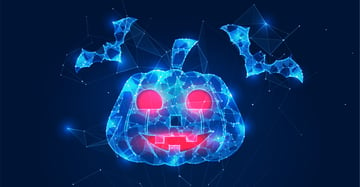Think back to your childhood Halloween haul. At the bottom of your pillowcase (or plastic pumpkin), there were always some gems. Rich chocolate bars, tangy lollipops, maybe even that king-sized candy that made your night. But mixed in, you likely found a few letdowns like raisins, fruit cups, or the dreaded orange that made you wonder if your neighbor was playing a cruel joke. It was a grab bag of both delights and disappointments.
That’s a lot like leaning on technology and artificial intelligence (AI) in hiring. These tools can feel like a sweet breakthrough, faster, smarter, more efficient. But they can also slip in a few unwanted surprises. So, are they show-stopping game-changer or damaging risk? The truth, as usual, lands somewhere in between.
Let’s look closer at the “tricks and treats” of using technology tools and AI in your company’s hiring process.
The Treat: Improved hiring efficiency and speed.
LinkedIn’s 2025 Future of Recruiting Report says that 73% of talent acquisition pros agree that AI will change the way organizations hire. It’s easy to see why. AI-driven tools can scan thousands of resumes in a fraction of the time it would take a human recruiter. By automating repetitive tasks like resume screening, scheduling interviews, and even providing initial candidate assessments, AI allows HR teams to focus on the elements of the hiring process that require human eyes and intellect.
For example, AI-powered platforms can pre-screen candidates based on specific job requirements, rank them according to qualifications, and predict their potential success in a role. This streamlines the hiring process and can significantly reduce time-to-hire, especially in high-volume hiring situations.
The Trick: The risk of bias.
AI systems are only as good as their data. If an AI algorithm is fed biased data, the AI may perpetuate those biases. For example, if a company’s historical hiring practices have favored one demographic over another, the AI system might, too.
AI has the potential to accidentally screen out diverse candidates if the algorithm is skewed toward a particular profile. HR professionals must cautiously approach using AI, ensuring the tools they use are regularly audited to be fair and minimize bias.
The Treat: Data-driven decision-making.
AI can analyze vast amounts of data, which helps hiring managers spot trends and patterns that might otherwise go unnoticed. These reviews can lead to better hiring outcomes, as decisions are made based on data-driven insights rather than gut feelings.
For example, AI can predict which candidates are most likely to succeed in a role based on historical performance data. It can also provide insights into which job postings attract the most qualified applicants. Using predictive analytics can make recruitment more strategic and better align it with business goals.
The Trick: Compliance challenges and legal risks.
AI is still somewhat of a “Wild, Wild West”. Laws and regulations governing AI use in employment practices are constantly developing, and HR professionals must stay informed about compliance requirements.
According to The National Conference of State Legislatures, during the 2025 legislative session, all 50 states, Puerto Rico, the Virgin Islands, and Washington, D.C. have introduced legislation on this topic. Thirty-eight states adopted or enacted around 100 measures this year. This intricate patchwork of AI laws is challenging to keep up with. It’s especially complex for businesses operating across the U.S. and internationally.
Another potential risk is that AI’s use in collecting and analyzing candidate data raises privacy concerns. Companies need to ensure that they are following data protection laws like the California Consumer Privacy Act (CCPA).
The Treat: A stronger candidate experience.
Technology and AI help provide faster feedback, offer personalized communication, and reduce friction in the application process. Chatbots, for example, can answer candidate questions in real-time, while AI-driven systems can offer personalized job recommendations based on the candidate’s profile.
These tools make the hiring process more engaging and candidate-friendly. Applicants can track their application status and receive automated updates, improving their perception of your company and its hiring process.
The Trick: Missing important qualities because of automation.
Yes, AI can streamline many tasks. However, over-reliance on automation can sometimes cause important qualities to be overlooked that would make a candidate a successful addition. While it excels in handling hard skills and qualifications, AI can struggle to assess soft skills, cultural fit, and the creative thinking required in certain roles. These elements are often better identified through human oversight.
The Treat: Consistency in hiring.
Consistency is crucial. AI gives companies the ability to apply the same criteria and processes to every candidate, ensuring a level playing field. Unlike humans, AI doesn’t experience fatigue, illness, or distractions when screening resumes or conducting interviews. This ensures all candidates are judged by the same standards, resulting in a more fair and objective hiring process.
The Bottom Line? Use, but Don’t Over-Rely, On Tech and AI
While the HR technology and AI bag may have some tricks mixed in with the treats, it can still benefit your organization. They can offer numerous benefits like efficiency, data-driven insights, and an improved candidate experience. However, these tools also come with potential risks like bias, compliance challenges, and the temptation of over-reliance. To fully embrace the advantages of AI in hiring, HR professionals must approach these tools carefully and understand their limitations.
By striking the right balance between AI and human oversight, you can capitalize on the power of technology while keeping your hiring practices inclusive, ethical, and compliant.



